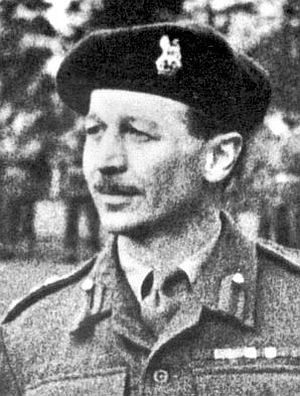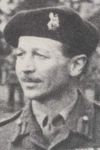Sir John Winthrop Hackett (1910 - 1997)
Youth and education
John Winthrop Hackett was born on November 5th, 1910 in Perth, Western Australia and was the son of Sir John Winthrop Hackett, a prominent Australian judge and owner of two Australian newspapers. After leaving high school in Geelong he went to the London Central Art School where he followed an education to become a painter artist. Thereafter he frequented New College in Oxford which he finished with a master’s degree in literature. After he finished his studies he had been looking forward to become a don there, but as his qualifications were judged not to be sufficient, he was turned down and he decided then to join the British army. He was enlisted with the 8th King’s Royal Irish Hussars, of which he later said that he did not join the army but ended up in the regiment of his great grandfather. During his military training he also succeeded in completing a study in history with focus on the crusades and the early Middle Ages. He also followed studies in various languages amongst which German, French, Italian and Arabic. Finally he studied ten languages.
His early military career
In 1936 he was transferred to Palestine, where he was placed with the anti-terrorist unit. For his share in the fighting of terrorism he was ‘Mentioned in Dispatches’ in the same year. The next year he was part of the Trans-Jordan Frontier Force, the only well organized, regular force, commanded by British officers in the Middle East. Also here he was ‘Mentioned in Dispatches’ twice. He got wounded in 1940 during the campaign against the French Vichy forces in Syria. During his recovery period, one year later he met with Margaret Fena in Palestine, an Austrian widow. In spite of the fact that she was considered to be German because of her former marriage, he persisted and gained permission from the authorities to marry. The wedding took place in 1942 in the Cathedral of St. George in Jerusalem. In that year he was again wounded during battle in West Africa. Here he was part of the staff of General Bernard Montgomery and was charged with the supervision and organization of the so called ‘Raiding Forces’. These consisted of independent units that operated mainly behind enemy lines, like the Long Range Desert Group, the Special Air Services and Popski’s Private Army. In 1943, at the age of 33, he was charged with the command and the establishing of the 4th Parachute Brigade. This made him the youngest Brigadier of the British Army. Because of his performance in Italy, he was again ‘Mentioned in Dispatches’, now for the fourth time. In the meantime he was awarded the Military Cross (1941) and the DSO (1942).
The battle for Arnhem
On 18 September 1944 at approximately 15:00 Hackett and his 4th Paratroopers Brigade landed at the Ginkelse Heide, in the Oosterbeek area, as a part of the Operation Market-Garden. A quarter of an hour later, the brigade was an operational unit with 75 to 80 % of its capacity. Then suddenly the unnerving message came through that the advance by the 1st Parachtist Brigade had been brought to a halt; Hackett had to render his 11th Battalion to this 1st Brigade and Hackett’s strength had been reduced with one third of his force. In the meantime the units that had been landing with gliders were added to his brigade together with the vehicles and guns of the 2nd Airlanding Anti-Tank battery. After having reorganized his brigade he advanced in the direction of Oosterbeek towards Hotel Hartenstein. Because in the meantime the Commander in Chief of the division, Roy Urquhart, was missing in Arnhem, he took command together with Brigadier Hicks, which did not always go very smoothly. During the fighting that followed the next days Hackett received the command of the eastern perimeter in Oosterbeek and from this position he was able to lead the defenses in an adequate way.
Early in the morning of 24 September Hackett was hit by shrapnel of a mortar bomb. After medical doctor Randall had nursed him with first aid in the Regimental Aid Post of Hotel Hartenstein he was transferred to the Elisabeth Gasthuis (= a local hospital) in Arnhem. Dr. Lipmann Kessel carried out a difficult belly operation under very difficult circumstances and with only limited material. Hackett had been entered on the list of patients as a corporal, so the Germans did not realize that they had an important man in their hands.
After 10 days the resistance under the command of Piet Kruyff, one of the most important resistance leaders of Arnhem, kidnapped him from the hospital after which he found shelter with the ladies De Nooij in Ede. Hackett received a forged Dutch passport in the name of Johan van Dalen and was provided with an insignia to indicate that he was hard of hearing. And under guidance of Johan Snoek, the sun of one of the De Nooij-sisters, he succeeded four months later to reach the liberated part of The Netherlands via the Biesbosch, after an adventurous bicycle ride through the occupied part of The Netherlands. A day later Hackett returned to England and in the evening the message “the goose is gone” was received during the Dutch broadcast of the BBC.
Because of his behavior during and after the battle for Arnhem he was awarded the second Distinguished Service Order (Clasp) on 24 May 1945 followed on 20 September of that year a fifth “Mentioned in Dispatches”. About his experiences during and after the battle for Arnhem he wrote a book in 1977 with the title “I was a stranger” which was two years later translated into Dutch with the title “Ik ben een vreemdeling geweest”.
The years after the war
After the war Winthrop Hackett pursued his military career and achieved a number of high positions. In 1947 he was in command of the Trans-Jordan Frontier Force, the only real military force in the Middle East. He was involved in the skirmishes of this army and finally in its dismantling at the establishing of the state of Israel. After he finished successfully his studies at the Imperial Defence College he was promoted to Major General and appointed Commander of 7th British Armoured Division after a period when he commanded the 20th British Armoured Division in Germany. In 1958 he was promoted to the position of Director of the Royal Military College of Science in Shrivenham. Three years later his promotion as Lieutenant General followed and he became General Officer-Commander in Chief of the British forces in Northern Ireland. In 1963 Hackett was appointed as Deputy Chief of the Supreme Command and he was made responsible for the organization and weapon development of the whole of the British Army. In his next position he was made commander of the British forces at the river Rhine (BAOR) and at the same time commander of the Northern NATO Army Group.
In 1968 he left the army at an age of 58 and was appointed Principal of King’s College in London. After his retirement he was lecturing and started to write in earnest. One of his most famous publications was “The third world war; the untold story” with which he pointed at the strategic importance of the Middle East and with which he described the disintegration of the Soviet Union.
Many honorable awards were bestowed on him and during exciting days of foreign policy his unchallenged authority and his sharp analyzing capabilities were popular with TV and radio journalists and issued in important newspapers. Both during the Falkland war as well as during the Gulf war he was an estimated commenter. On 9 September 1997, more than a week before the 53rd memorial of the Battle for Arnhem he passed away at the age of 86 in his mansion at Cheltenham in Gloustershire. Several times Sir John Winthrop Hackett Junior was the “Leader of the Pilgrimage”, the last time at the 50th memorial parade in 1994 at Arnhem.
Definitielijst
- Brigade
- Consisted mostly of two or more regiments. Could operate independently or as part of a division. Sometimes they were part of a corps instead of a division. In theory a brigade consisted of 5,000 to 7,000 men.
- division
- Military unit, usually consisting of one upto four regiments and usually making up a corps. In theory a division consists of 10,000 to 20,000 men.
- mortar
- Canon that is able to fire its grenades, in a very curved trajectory at short range.
- Paratroopers
- Airborne Division. Military specialized in parachute landings.
- regiment
- Part of a division. A division divided into a number of regiments. In the army traditionally the name of the major organised unit of one type of weapon.
- resistance
- Resistance against the enemy. Often also with armed resources.
- Soviet Union
- Soviet Russia, alternative name for the USSR.
Images
Information
- Translated by:
- Fred Bolle
- Published on:
- 10-08-2012
- Last edit on:
- 24-11-2023
- Feedback?
- Send it!
Sources
- Roekel C. van, Mini story belonging to the Newsletter nr 70 of Friends of the Airborne Museum.
- Newsletter nr 68 of Friends of the Airborne Museum.
- “The Times” Wednesday 10 September, 1997.
- “The Daily Telegraph” Wednesday 10 September, 1997.









